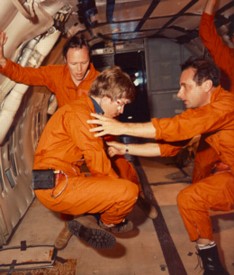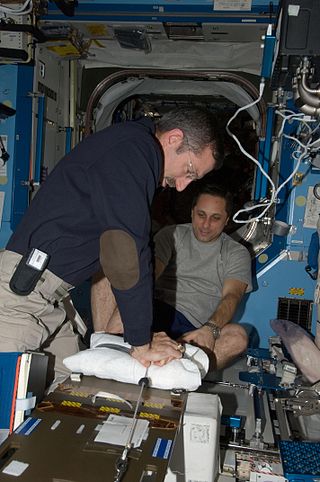
An astronaut is a person trained, equipped, and deployed by a human spaceflight program to serve as a commander or crew member aboard a spacecraft. Although generally reserved for professional space travelers, the term is sometimes applied to anyone who travels into space, including scientists, politicians, journalists, and tourists.

STS-41 was the 36th Space Shuttle mission and the eleventh mission of the Space Shuttle Discovery. The four-day mission had a primary objective of launching the Ulysses probe as part of the "International Solar Polar Mission" (ISPM).

Space adaptation syndrome (SAS) or space sickness is a condition experienced by as many as half of all space travelers during their adaptation to weightlessness once in orbit. It is the opposite of terrestrial motion sickness since it occurs when the environment and the person appear visually to be in motion relative to one another even though there is no corresponding sensation of bodily movement originating from the vestibular system.

The effects of spaceflight on the human body are complex and largely harmful over both short and long term. Significant adverse effects of long-term weightlessness include muscle atrophy and deterioration of the skeleton. Other significant effects include a slowing of cardiovascular system functions, decreased production of red blood cells, balance disorders, eyesight disorders and changes in the immune system. Additional symptoms include fluid redistribution, loss of body mass, nasal congestion, sleep disturbance, and excess flatulence. Overall, NASA refers to the various deleterious effects of spaceflight on the human body by the acronym RIDGE.

Space medicine is an area in aerospace medicine that focuses on the medical care of astronauts and spaceflight participants. The spaceflight environment poses many unique stressors to the human body, including G forces, microgravity, unusual atmospheres such as low pressure or high carbon dioxide, and space radiation. Space medicine applies space physiology, preventive medicine, primary care, emergency medicine, acute care medicine, austere medicine, public health, and toxicology to prevent and treat medical problems in space. This expertise is additionally used to inform vehicle systems design to minimize the risk to human health and performance while meeting mission objectives.

The Neutral Buoyancy Laboratory (NBL) is an astronaut training facility and neutral buoyancy pool operated by NASA and located at the Sonny Carter Training Facility, near the Johnson Space Center in Houston, Texas. The NBL's main feature is a large indoor pool of water, in which astronauts may perform simulated EVA tasks in preparation for upcoming missions. Trainees wear suits designed to provide neutral buoyancy to simulate the microgravity that astronauts experience during spaceflight.
The conditions governing sex in space have become a necessary study due to plans for long-duration space missions, as well as the future potential accommodation of sexual partners aboard the International Space Station (ISS). Issues explored include disrupted circadian rhythms, radiation, isolation, stress, and the physical acts of intercourse in zero or minimal gravity.

Bioastronautics is a specialty area of biological and astronautical research which encompasses numerous aspects of biological, behavioral, and medical concern governing humans and other living organisms in a space flight environment; and includes design of payloads, space habitats, and life-support systems. In short, it spans the study and support of life in space.
Astronautical hygiene evaluates, and mitigates, hazards and health risks to those working in low-gravity environments. The discipline of astronautical hygiene includes such topics as the use and maintenance of life support systems, the risks of the extravehicular activity, the risks of exposure to chemicals or radiation, the characterization of hazards, human factor issues, and the development of risk management strategies. Astronautical hygiene works side by side with space medicine to ensure that astronauts are healthy and safe when working in space.
Health threats from cosmic rays are the dangers posed by cosmic rays to astronauts on interplanetary missions or any missions that venture through the Van-Allen Belts or outside the Earth's magnetosphere. They are one of the greatest barriers standing in the way of plans for interplanetary travel by crewed spacecraft, but space radiation health risks also occur for missions in low Earth orbit such as the International Space Station (ISS).

Weightlessness is the complete or near-complete absence of the sensation of weight, i.e., zero apparent weight. It is also termed zero g-force, or zero-g or, incorrectly, zero gravity.
ELIPS - European Programme for Life and Physical Sciences in Space and applications utilising the International Space Station started in 2001 and was intended to cover the activities for the following 5 years. This Microgravity Programme at the European Space Agency (ESA) is an optional programme, with currently 17 ESA member states participating. The ELIPS programme prepares and performs research on the International Space Station, and other uncrewed mission platforms like Sounding Rockets, in fundamental and applied life and physical sciences. ELIPS is the continuation of the earlier European microgravity programmes EMIR 1&2, and the Microgravity Facilities for Columbus, MFC.
Space neuroscience or astroneuroscience is the scientific study of the central nervous system (CNS) functions during spaceflight. Living systems can integrate the inputs from the senses to navigate in their environment and to coordinate posture, locomotion, and eye movements. Gravity has a fundamental role in controlling these functions. In weightlessness during spaceflight, integrating the sensory inputs and coordinating motor responses is harder to do because gravity is no longer sensed during free-fall. For example, the otolith organs of the vestibular system no longer signal head tilt relative to gravity when standing. However, they can still sense head translation during body motion. Ambiguities and changes in how the gravitational input is processed can lead to potential errors in perception, which affects spatial orientation and mental representation. Dysfunctions of the vestibular system are common during and immediately after spaceflight, such as space motion sickness in orbit and balance disorders after return to Earth.

Astronaut training describes the complex process of preparing astronauts in regions around the world for their space missions before, during and after the flight, which includes medical tests, physical training, extra-vehicular activity (EVA) training, procedure training, rehabilitation process, as well as training on experiments they will accomplish during their stay in space.
It is inevitable that medical conditions of varying complexity, severity and emergency will occur during spaceflight missions with human participants. Different levels of care are required depending on the problem, available resources and time required to return to Earth.
Even before the very beginning of human space exploration, serious and reasonable concerns were expressed about exposure of humans to the microgravity of space due to the potential systemic effects on terrestrially-evolved life forms adapted to Earth gravity. Unloading of skeletal muscle, both on Earth via bed-rest experiments and during spaceflight, result in remodeling of muscle. As a result, decrements occur in skeletal muscle strength, fatigue resistance, motor performance, and connective tissue integrity. In addition, there are cardiopulmonary and vascular changes, including a significant decrease in red blood cell mass, that affect skeletal muscle function. This normal adaptive response to the microgravity environment may become a liability resulting in increased risk of an inability or decreased efficiency in crewmember performance of physically demanding tasks during extravehicular activity (EVA) or upon return to Earth.
Heart rhythm disturbances have been seen among astronauts. Most of these have been related to cardiovascular disease, but it is not clear whether this was due to pre-existing conditions or effects of space flight. It is hoped that advanced screening for coronary disease has greatly mitigated this risk. Other heart rhythm problems, such as atrial fibrillation, can develop over time, necessitating periodic screening of crewmembers’ heart rhythms. Beyond these terrestrial heart risks, some concern exists that prolonged exposure to microgravity may lead to heart rhythm disturbances. Although this has not been observed to date, further surveillance is warranted.
The following page is a list of scientific research that is currently underway or has been previously studied on the International Space Station by the European Space Agency.

Locomotion in space includes all actions or methods used to move one's body in microgravity conditions through the outer space environment. Locomotion in these conditions is different from locomotion in a gravitational field. There are many factors that contribute to these differences, and they are crucial when researching long-term survival of humans in space.
The ISS U.S. National Lab, commonly known as the ISS National Lab, is a U.S. government-funded national laboratory established on 30 December 2005 by the 2005 NASA Authorization Act. With principal research facilities located in the United States Orbital Segment (USOS) of the International Space Station (ISS), the Laboratory conducts research in life sciences, physical sciences, technology development and remote sensing for a broad range of academic, government and commercial users. Of the 270 payloads that the Center for the Advancement of Science in Space (CASIS) has sent to the ISS, 176 have been for commercial companies including Merck & Co., Novartis, Eli Lilly and Company, Hewlett Packard Enterprise, Honeywell, and Procter & Gamble.













